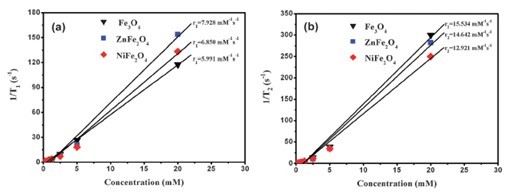It is well known that the dispersibility of ultrasmall iron oxide nanoparticles is significant for the application in biomedicine. The cost of the synthesis using a thermal decomposition method is high and the synthesized product has high cytotoxicity and poor water dispersibility. Up to now, to the best of our knowledge, although the synthesis of ultrasmall iron oxide nanoparticles by a hydrothermal method using vitamin C as a reducing agent has been widely studied, the water-phase synthesis at room temperature is still not reported. The researchers from the Ningbo Institute of Materials Technology & Engineering (NIMTE) led by Prof. Aiguo Wu and Dr. Leyong Zeng have explored the water-phase synthesis of ultrasmall monodisperse metal-iron oxide nanoparticles as T1-weighted MRI contrast agents.
Using an improved hydrolysis method of inorganic salts assisted with water-bath incubation, ultrasmall water-soluble metal-iron oxide nanoparticles (including Fe3O4, ZnFe2O4 and NiFe2O4 nanoparticles) were synthesized in aqueous solutions, which can be used as T1-weighted contrast agents for magnetic resonance imaging (MRI). The morphology, structure, MRI relaxation properties and cytotoxicity of the metal-iron oxide nanoparticles were studied. The results show that the average sizes of nanoparticles are about 4 nm, 4 nm and 5 nm for Fe3O4, ZnFe2O4 and NiFe2O4 nanoparticles, respectively.
Moreover, the nanoparticles have good water dispersibility and low cytotoxicity. The MRI test show the strong T1-weighted, but the weak T2-weighted MRI performance of metal-iron oxide nanoparticles. The high T1-weighted MRI performance can be attributed to the ultrasmall size of metal-iron oxide nanoparticles. Therefore, the metal-iron oxide nanoparticles with good water dispersibility and ultrasmall size can have potential applications as T1-weighted contrast agent materials for MRI.

Fig. 1 TEM images of ZnFe2O4 (a) and NiFe2O4 (b) nanoparticles. Both ZnFe2O4 and NiFe2O4 nanoparticles are well dispersed, and the size is also uniform. The size of ZnFe2O4 nanoparticles is about 3-5 nm (the average size was 4 nm), and the size of NiFe2O4 nanoparticles is about 4-7 nm (the average size was 5 nm).

Fig. 2 Plots of 1/T1 (a) and 1/T2 (b) over concentrations of MFe2O4 (M = Fe, Zn, Ni) nanoparticles. Based on the T1, T2 values and the corresponding concentrations of MFe2O4 (M = Fe, Zn, Ni) nanoparticles, the longitudinal and transverse relaxivities (r1 and r2) of MFe2O4 (M=Fe, Zn, Ni) nanoparticles could be calculated, respectively. It can be found that the r1 values of MFe2O4 (M = Fe, Zn, Ni) nanoparticles were 5.991, 7.928, and 6.850 mM-1 s-1, and the r2 values were 15.534, 14.642, and 12.921 mM-1 s-1, respectively. The r2/r1 ratios of MFe2O4 (M = Fe, Zn, Ni) nanoparticles were 2.59, 1.85, and 1.89, respectively. The low r2/r1 ratio values indicated that the MFe2O4 (M = Fe, Zn, Ni) nanoparticles had strong T1-weighted MRI relaxation properties, and could be good candidates as T1-weighted MRI contrast agents.
Above research work has been published in Phys Chem Chem Phys 2012; 14: 2631-2636.
Group Leader Prof. Aiguo Wu (aiguo@nimte.ac.cn)
(Images by NIMTE)

